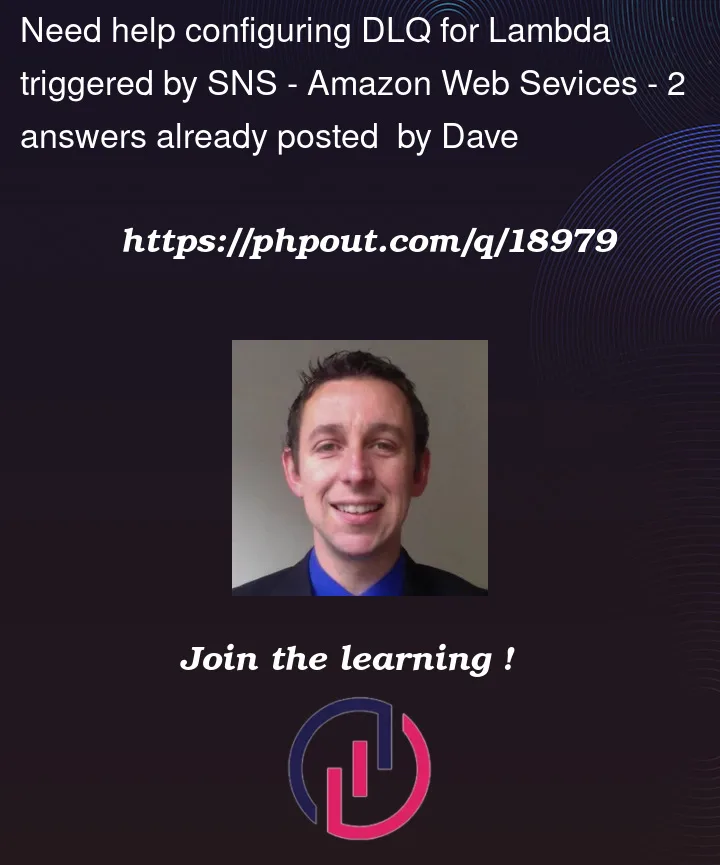I’d like to receive an email if my Lambda fails. The Lambda is triggered via SNS (which is triggered by SES).
When I publish to the SNS Topic, the Lambda runs and throws an error (for testing) due to a missing package. I see from the console logs that the Lambda runs 3 times.
I have an SQS queue attached to the Redrive policy (dead-letter queue) of the SNS Topic’s subscription (that triggers the lambda).
{
"deadLetterTargetArn": "arn:aws:sqs:us-east-1:123456789012:myproj-sns-topic-dlq"
}
I tested, and things didn’t work. I noticed a warning in the AWS console for the SNS Topic’s subscription:
Dead-letter queue (redrive policy) permissions The Amazon SQS queue
specified as the dead-letter queue for your subscription (redrive
policy) doesn’t permit deliveries from topics. To allow an Amazon SNS
topic to send messages to an Amazon SQS queue, you must create an
Amazon SQS queue policy.
Following the steps Subscribing an Amazon SQS queue to an Amazon SNS topic, I added the 2nd statement to my SQS queue’s Access policy:
{
"Version": "2008-10-17",
"Id": "__default_policy_ID",
"Statement": [
{
"Sid": "__owner_statement",
"Effect": "Allow",
"Principal": {
"AWS": "arn:aws:iam::123456789012:root"
},
"Action": "SQS:*",
"Resource": "arn:aws:sqs:us-east-1:123456789012:myproj-sns-topic-dlq"
},
{
"Effect": "Allow",
"Principal": "*",
"Action": "sqs:SendMessage",
"Resource": "arn:aws:sqs:us-east-1:123456789012:myproj-sns-topic-dlq",
"Condition": {
"ArnEquals": {
"aws:SourceArn": "arn:aws:sns:us-east-1:123456789012:myproj-snstopic"
}
}
}
]
}
The Principal was {"Service": "sns.amazonaws.com"}, but that results in a warning in the AWS console saying it can’t test permissions. I tested anyway and it didn’t work. (Lambda runs 3 times, but nothing gets put in the DLQ.)
I set the Principal to * for now (per snippet above). That eliminates the warning in the console, but things still don’t work.
My goal it to have the event drop into the SQS DLQ after the Lambda fails. I have an alarm on that queue that will notify me by email…
Edit: added missing condition




2
Answers
As pointed out by @fedonev, the SNS Subscription's (for lambda) DLQ is used when the event cannot be delivered. If the event is delivered (but the Lambda fails), you can use Lambda's async event DLQ or wire-up the 'on failed' destination of the Lambda.
I'm using AWS Amplify and decided to use the Lambda's "async" DLQ as opposed to a lambda destination.
Step 1 - Add a custom category to add:
And "Output" the SQS queue's ARN which is needed by the Lambda.
Step 2 - Add a "DeadLetterConfig" to the Lambda that pushes fails into the above queue.
amplify add customname: LambdaAlarm
File:
amplify/backend/custom/LambdaAlarm/LambdaAlarm-cloudformation-template.jsonNext, update and add the new custom resource as a dependency of the Lambda(s) to monitor.
File:
backend-config.jsonIn the Lambda(s) you want to monitor, make 3 changes to the cloudformation:
customLambdaAlarmSQSDLQArn) from your custom category and add it to theParametersDeadLetterConfigproperty to the LambdaFile:
amplify/backend/function/MyLambda/MyLambda-cloudformation-template.jsonFinally, due to an Amplify quirk you must
amplify env checkout devbecause you manually touched thebackend-config.jsonfile.Then you can deploy your changes. The above is not specific to AWS Amplify.
According to this article, you can use a CloudWatch Log filter to parse a log for a Lambda function and get an email notification.
To implement this solution, you must create the following: